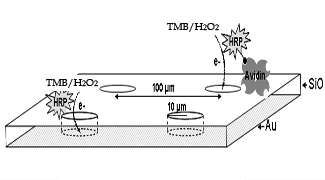Increased quality of biosensors using micrelectrode arrays

An innovative approach in the development of biosensors has been proposed int his research. It is usual to fix biological receptors on the surface and treat it with a polymer to prevent nonspecific response of the sensor, which often lead to problems in signal transduction. The novelty is to use microelectrode arrays of gold, enfolded by a passivating silicon oxide, on which receptors would be set. Thus, signals intensity has been considerably increased and it is easier to clean and to activate the sensor electrochemically.
Biosensor performance strongly depends on the effective functionalisation of the transducer with suitable biorecognition elements (such as antibodies, bioreceptors or DNA probes specific towards the target under study). During functionalisation, surface blocking steps are normally carried out in order to avoid later binding of undesirable molecules and thus guarantee biosensor specificity. However, these blocking steps may be deleterious in electrochemical systems where transduction ultimately relies on electron transfer between the electrode and a redox species in solution.
This work presents a novel approach to develop improved amperometric biosensing platforms using microfabricated disk microelectrode arrays. As illustrated in the figure, this type of devices is composed by a high number of disk-shaped microelectrodes connected in parallel, which are physically defined and separated by a layer of silicon oxide/nitride. The reported biosensors based on microelectrode arrays rely on direct functionalisation of the disks. We now demonstrate that the inert surface surrounding the active microdisks can be alternatively modified, making possible improved electrochemical detection at bare microelectrodes. The devices treated in this way more than doubled assay sensitivity compared to conventional biosensors.
To demonstrate this, we compared the electrochemical detection of the enzyme horseradish peroxidase (HRP) and its substrate H2O2 at microelectrode arrays used as conventional biosensors and as the reported sensing platforms. The second strategy produced significantly better results in all cases, with detection down to 0.54 pM for H2O2 or as little as 25 pM for HRP, within assay times of just seconds and in 10 µl of sample volume.
Figure.- H2O2 detection using microelectrode arrays as a classical sensor (HRP directly immobilised onto the gold disks), or as a sensor platform (the passivating layer is modified with HRP and disks are electrochemically activated immediately prior to detection). The negative control was performed on unmodified electrodes.
References
"Biosensing at disk microelectrode arrays. Inter-electrode functionalisation allows formatting into miniaturised sensing platforms of enhanced sensitivity". Baldrich, Eva; Javier del Campo, Fco.; Xavier Muñoz, Francesc. BIOSENSORS & BIOELECTRONICS, 25 (4): 920-926 DEC 15 2009.


